by MHolland | May 7, 2020 | Business Tips
Everything is going virtual, right? Zoom meetings. Cloud-based accounting. Online banking. VOIP phones. Website portals.
The pandemic has forced businesses to figure out new ways to work online.
How do you market right now?
Tip #1 – Create an Awesome Service Experience Online
Let us say you own a restaurant. It has been forced to stop due to Covid 19. First question is – can you shift to takeout or catering?
How do you create an awesome service experience online?
First, look at all the points where your customer “engages with your business”.
In a restaurant these touch points are:
- Phone
- Website
- Email
- Waiter/waitress
- The Food
- Parking lot
- Front entrance
- Host/Hostess
- Physical layout
- Bathrooms
Moving the restaurant online, the touch points are:
- Phone
- Website
- Email
- Delivery man/woman
- The Food
- Packaging
- Extras
- Cleanliness of delivery vehicle
See the overlap? Five are the same. Three are new touch points.
Now, walk through each touch-point and re-engineer this business for awesome experience.
This could include:
- A re-designed website, with the daily menu and specials on the front page.
- An online-order-portal. This is where customers order and pay.
- Spiffy branded uniforms for the delivery people.
- Branded, colorful packaging.
- Training for the Team in scripts you want said as you deliver food.
- Scripts for answering the phone.
Systems for phone answering are critical. Answering the phone on the second ring – every time – creates consistency. Consistency at this time wows people. This has them keep coming back.
Tip #2 – What is Old Can Become New Again
Marketing can be offline. You can be bold and try “new” things.
When everyone is marketing online, try something old: direct mail.
Direct mail may surprise prospects. They are not getting much mail. Odds are they may read your letter.
The big challenge is a lot of businesses are working from home. Where to send your mail? Getting the right address will be crucial.
Direct mail must be followed up with a phone call.
My coaching is trying a small number to start (25-50 leads). Then call each one the following week.
Take a problem solving, non-salesy approach. Few businesses want to be sold to in a pandemic. Do you have a service that can fix a problem or save them money? They may be eager to listen to you.
I hope this helps. Thanks for reading…
by MHolland | Dec 11, 2019 | Business Tips
Many people might answer the question above by saying, “to make a profit”.
After all, why else would you be in business, if not to succeed and make a profit?
Fair enough, however, consider in another area of your life – health. Would you ever say, the purpose of my life in the area of health is to lose weight?
Losing weight and earning a profit are simply results of doing the right activities.
I would like to suggest that all businesses could have the same over-arching Strategic Purpose that is composed of 4 parts.
I can hear the groans already! What! The same Strategic Purpose as all other businesses?? How does that work? My business is unique, I can hear you saying…
Hang on, you are right, your business has a very unique strategic focus.
The 4 Purposes of a Business I am about to share with you are the umbrella that you hang all the specific things you will do to achieve your overall purpose.
Purpose #1 – To Create New Customers
If you are not in business to create new customers, then what are you in business for? Certainly, I am sure we can all agree that creating new customers is valid for all businesses.
Now, you will uniquely apply your creativity to figure out specifically how you will create new customers.
There are only two realities here – either you have nothing to sell, or you do, yet cannot convince people to buy it for any number of reasons – price, quality, need, timing, workability, competition and so on.
Ok, I know this is very basic, yet you must have a way to create new customers, or you don’t have a business.
Purpose #2 – To Make Sure They Keep Coming Back
Now, you have created new customers, how do you make sure they keep coming back?
Some businesses (no one reading this!) are like revolving doors. A customer comes in the front door and leaves, never to return, out the back door.
They leave, at about the statistically proven rate of 7/10 if they perceive you do not care.
Here, to ensure they keep coming back you must offer great products and services at fair prices, together with great service and incentives to make sure they keep coming back.
Can you see where this is going? It is not enough to create new customers; you must ensure they keep coming back.
Also, you can start thinking of how to ensure they keep coming back! Your own unique creative ways.
Purpose #3 – To Turn Those People into Advocates for You
Now it is getting progressively more challenging. To get customers coming back more often is one thing, to turn them into advocates for your business is something entirely different.
First, what exactly is an advocate?
An advocate is someone who is a walking billboard for your business. They love the service so much that they don’t just come back, they cannot stop talking about you.
Can you think of a business that you use as a supplier, or perhaps are a retail customer of, that you rave about? You literally cannot help talking about that business. It takes more to create advocates than just having great products and services. It takes more than having awesome service.
You have to exceed your customers expectations in both the core product/service of your business and also in how it is delivered – the soft skills in customer service delivery.
Take a look at this Chart below to see the rarity of it (only one box is reserved for it):
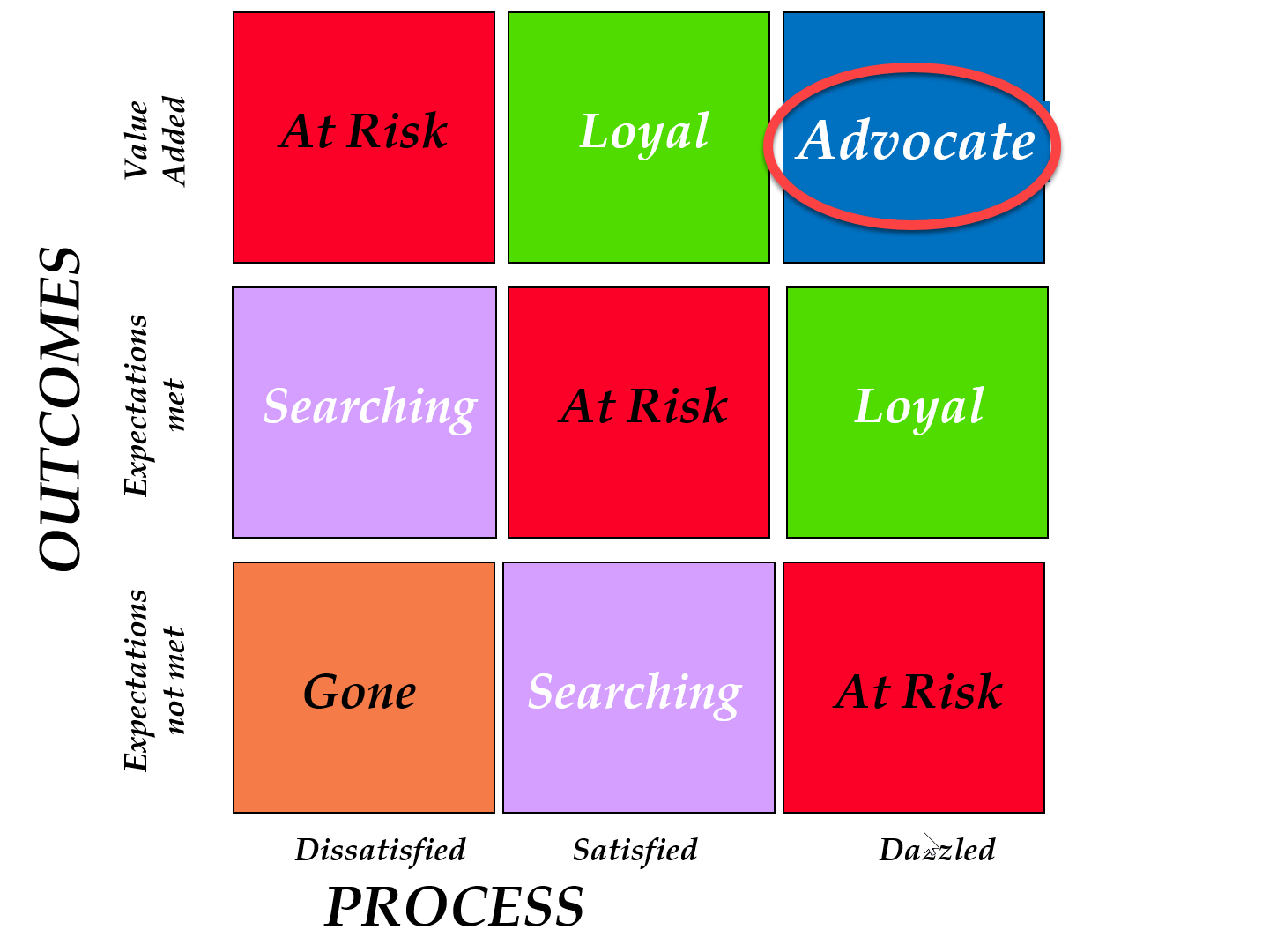
Starting at the bottom, if you do not meet your customer’s needs and they are dissatisfied with the service, they are “gone”.
They are searching for an alternative to your business when the service is satisfactory, but their needs are not met, or they are met and the service sucks.
You are “at risk” of losing them when you have added real value in your products or services yet service is bad, or if you have “just met” their expectations and they are “just satisfied” with the service, or lastly if you even dazzled them with awesome service yet the outcome was not met (shoddy product).
You can have loyal customers when you add extra value beyond “needs met” and satisfy them with service, or if you met their outcomes and dazzled them with great service.
The only box in the top right, reserved for your advocates, comes from exceeding their expectations in the outcome of the actual product/service and you coupled that to dazzling service.
Once you have that, you will need to spend very little on marketing because your customers will be raving all over town about your business…
Purpose #4 – To Have Fun Doing What You Do
If you and your Team are actually having fun (and that too is unique to each business) combined with the above three purposes, you will be rocking.
You will be adding value to your Team Member’s lives, your customers will sense the vibe of your business and be attracted to your special flavour of fun.
Having fun does not mean being childish or having a Foosball game in your office. For you it could mean an inner sense of joy bubbling through, with light-hearted humour, care, and love for your Team.
It could be the family atmosphere you created with your Team.
In Summary
Creating new customers, keeping them coming back, turning them into advocates for your business, and having fun doing all that will be a very creative and unique challenge for you to solve for your business.
Can you also see how powerful that is, and that by doing this you would be pretty much assured that the profits are a result of taking actions in these 4 areas?
Thanks kindly for reading…
by MHolland | Dec 10, 2019 | Business Tips
Kindly note the word “conservatism” in accounting has absolutely nothing to do with whether you vote conservative, liberal, or NDP! Ok, now I’ve got that out of the way, let’s define what it means in accounting.
Conservatism in accounting simply means this – that revenue is recognized only when it is assured of being realized (you could say in simple business terms – will I get paid?), and expenses are recognized sooner when there is a reasonable possibility they will be incurred (in other words, you will be liable to pay).
In other words, a cautionary approach is taken which creates more reliable financial statements for users.
Which is why I hate deferred expenses, as I wrote about in a prior Blog. People rationalize deferring expenses (putting on the Balance Sheet as an asset, rather than expensing on the Profit and Loss Statement) by applying (mis-applying?) the matching principle.
As a refresher, let’s talk about what a deferred expense is. A deferred expense (as opposed to a prepaid expense which is different. I will explain later) is an expense that was incurred now, that you think will have a future value in your business. So, you move it off your Income Statement to your Balance Sheet. In other words, you “defer” it to a later date. Sometime in the future, you will expense it.
When you don’t apply the “conservatism” principle in accounting what happens is you end up creating financial statements that cannot be relied upon. They end being full of assumption-based not fact-based.
Let us see how this works by examining a Balance Sheet…
Every Item on Your Balance Sheet Tells a Story
If you were to go through every line item on your Balance Sheet you could tell me a story about it.
Really, you could. The story would either be a true story, based on verifiable facts, or it would be a made-up story, a fairy tale based on assumptions and projections or crystal-ball gazing.
The true stories you could verify. The fairy stories you would have to spin a tall tale.
Let’s go through some examples…looking just at the asset section of your Balance Sheet.
First, what is an asset?
An asset is something you own, something that has value. I could add more distinctions, however, let’s keep it simple for now.
Cash in the Bank
Together as we go through a Balance Sheet we start with “Cash in the Bank”. You unpack the details about this account, in other words, you tell a story.
You inform me that you own that bank account. It is in your company name. You can show me documented proof that you own it.
Is it the correct amount? You could pull out a bank reconciliation showing me your balance in the bank on that date, less cheques that haven’t cleared the bank yet, and deposits of cheques that haven’t been deposited at that time.
All facts, all clear. We can all agree on those facts.
Next, Accounts Receivable
Now you show me a number on your Balance Sheet that says – “this is how much my customers owe my business”.
Again, is this a true story? I don’t know yet. So, to back it up, you show me your accounts receivable list and that includes all the details of each customer and how much they owe you.
You also tell me that you have reviewed each item carefully and determined that they are good payers, and they all will actually pay you.
I may ask some questions – especially about the ones over 90 days.
Why?
Because it is well known that the older the account the less likely it will be of being collected.
Yet all of these are verifiable facts. I could see over the next few weeks how these accounts receivable are converted into cash.
Inventory
What is inventory?
Inventory is stuff on hand that you either bought from a supplier or built yourself that you will re-sell.
You show me how much your inventory is valued at.
Is it a true number or a phony number?
I don’t know. You need to show me your inventory. Show me the details – how many of this item and how many of that item? What did you either pay for it or what did it cost you to manufacture?
Can you sell it for that much I ask?
You tell me that yes, plus a profit, and that you even reduced the cost on some items to the actual sales value you believe you will get.
Do you start to see how this story is a story you can check up on by asking for more documents or even looking on shelves of widgets and count them?
Can you also see, that by writing things down, this becomes a conservative story?
When I say conservative, I mean you have taken the trouble (this is an accounting principle, by the way) to reduce the cost of certain items of inventory that you feel are worth less than what their cost is.
It is kind of like “under-promising” and “over-delivering”.
Fixed or Capital Assets
Next, I look on your Balance Sheet and see you have bought some capital items – things that do have a future value.
Why do they have a future value? Because they are things that will last longer than 1 year.
We can all agree that usually computers, cars, buildings and furniture do last more than 1 year.
You can show me these physical assets. You can pull out legal purchase agreements for what you bought. You can show me invoices.
You will also be depreciating those assets over the next few years based on your estimate of how many years they will last.
Although, the number of years they will last is unverifiable in reality, you, again, have taken a conservative approach. You have reduced their value by your estimate of the wear-and-tear, and reduction in value that occurs over time.
Goodwill and Other Intangibles
The next items in the asset section of your Balance Sheet are intangible items, like goodwill.
Goodwill – what’s that?
Great question! If you made it up, as in, this is the extra value my business has over and above it’s net assets that I can sell it for, then it is a real fairy story you are telling me.
If, on the other hand, you bought that goodwill, you actually paid for it to a third party, that is another matter altogether.
Now, you are able to show me purchase agreements and dollar figures.
Does it mean that it is worth what you paid for it? Sorry to say so, but likely not.
However, it is verifiable in that I can see an actual invoice.
To determine its actual real-life value, I would hire a business valuator to come in and assess the entire business and let him or her place a value on the goodwill.
Deferred Charges
Ok, dear reader, you have been very patient, and now for my rant…
Deferred charges are what exactly? Again, they are things that you would normally expense, however you have decided to defer them to some point in time in the future when you will write them off.
How did you determine this?
By assumptions. Now, the story takes a left turn.
For all the other items above you can show me verifiable documents for what you purchased. You can show me physical stuff even. You can show me bank statements, customer lists, and so on.
Now, you are telling me that these items – these deferred charges, or expenses, have some future value.
How did you determine that value? You tell me that you invested extra labour that will result in higher customer retention and that that cost can be matched to future revenue.
You have no agreements, no proof, no ability to validate the actual time frame involved.
Will it benefit business for 5 years? 10 Years? 1 year? You get to say because it is not based on anything real.
This is the opposite of the conservatism principle.
This is inflation. Inflating your assets to show a value that you cannot prove.
Increasing your income by reducing your expenses.
This is why a non-conservative approach to accounting creates monkey business. And it can defraud lenders and investors.
By the way, there are times you would defer expenses by following the conservatism principle. An example would be start-up development costs when a building is under construction. These would be capital costs in nature, and rightly placed on the Balance Sheet.
So, the moral of the story in this: whichever political party you support, in accounting always be conservative, and know that every number tells a story!
Thanks for reading…
by MHolland | Dec 6, 2019 | Business Tips
Michael Gerber, whose business books are huge bestsellers (millions sold) has coined some powerful, memorable phrases that hit you like a bullet, and you never forget.
One of those phrases is that business owners need to work “ON their business, not IN it”.
What exactly is Gerber getting at?
He is pointing to the truth that most businesses are started by technicians, not entrepreneurs, people who are really good at the technical skill of their business; they are not born entrepreneurs.
A lawyer starts a law practice, a plumber a plumbing business, a grower a gardening business; you get the idea.
The pull for a technician who is good at the operational side of the business will always be pulled into doing the technical work of the business.
The doing it, doing it, doing it in an endless cycle.
Can you relate, dear reader? (I know, I can, even after studying Gerber and practicing what he preaches the pull is to, as Nike says, “just do it”).
What Does Work “ON” Really Mean?
Working ON simply means taking a bigger view. When you work ON a project that is IN your business, you are not working ON you are working IN.
Let me explain.
Imagine (yes, this is an unlikely business!) that you sell model airplanes – fully assembled (would kind of take the fun away right!).
You are working ON assembling a model airplane. But raise your vision slightly.
You are in what department of your “assembled model airplane business”?
You are working in “operations”. So, imagine you were working ON the systems of your “operations” department.
You might start with Performance Standards for how you want the models assembled. You may create a detailed Systems Manual such that an average person could follow your system and do it the best way possible that produces a consistent outcome.
You could do the same for “marketing”, “finance, “human resources”.
Is that working “ON” your business?
Yes, and no. It is at a higher level than just working the shop floor.
The Eagle Eye View
Now rise up, take an eagle’s eye view of your business. Look at it as a whole.
How do all the moving parts work together.
Do you have a completed organizational chart?
Do you have a mission, values, a strategic action plan? A marketing plan?
When you work ON your business you are standing at the highest level, tinkering with your business as a whole.
This is when I tell people that, if you want to remain a kind of “technician”, just apply your technician mindset to the whole of your business.
Now, do you see a problem?
Go back to the beginning of this blog – most people that start a business are technicians – with very specific skills related to the work of the business.
The skills required to do the work of the business (assembling model airplanes, plumbing, real estate, accounting, you name it) is an entirely different skill set!
When I started my first accounting practice, I only had accounting skills. I knew very little of what it takes to run a business as a whole.
So, in the beginning I was the business. The business was not separate from me. If I stopped working, the revenue stopped, because I was the biggest earner.
I am Too Busy to Work On
Many of you reading this may be thinking “I am way too busy to work ON my business, I just don’t have the time, as much as I would like to work ON my business, I just cannot find the time”.
What is a busy person supposed to do?
As you are working IN your business, doing the work of the business, take some extra time to document what you do, as if you were delegating this work the very next day.
Start with bold, big steps and then drill down from there.
You must, (absolutely must! – I am shouting here!) write the steps down. It is not enough to think about them, you must document them.
So, write down systems as you are doing them or shortly thereafter.
I can hear the protests – I don’t even have time for that!
Ok, I won’t fight you on that – then you will have to accept always having a “business” that is almost entirely dependent on you.
And, if you are run over by a truck tomorrow, will your business continue smoothly without you?
Probably not.
You didn’t build anything to last.
Not Me, Who?
When you are working IN your business, before you jump into a task or work project, do this – STOP-WAIT, not JUMP-DO.
Then ask yourself this critically important question – “Not Me, Who?”
These three simple words will re-direct your thinking to who else could do it.
Ultimately – and this will take time – in a business that is done, complete and operating like a well-oiled machine, the only things left for you to do are – vision, planning, direction, motivating, and tinkering (with your systems, not the work inside your business).
What if I Love Working IN my Business?
That’s ok if you love working IN your business – so do I!
I love accounting, playing with numbers, connecting with clients.
Even after your business is operating like a synchronized swim team, you can choose to work in it. The difference is you are choosing it, you don’t have to!
I Don’t Have Great People
I have heard this complaint about not having good people in various forms my entire business career.
You must hire good people – you cannot make up for the bad child rearing many adults had!
With systems though, and high Performance Standards, your Team can excel in unimaginable ways!
And, here’s the thing. You will never have consistent PERFORMANCE without Performance Standards.
Even good people will each do it “their own way”.
Just imagine a fabulous, winning sports Team, do they not operate as one? Even with super stars, like Michael Jordan?
Written Performance Standards that are granular, simple, and can be monitored in physical reality are what I am talking about here.
The difference between a real Performance Standard and a fake one is that the fake one is a motherhood statement that cannot be monitored in physical reality.
Here’s an example – Performance Standard 1 – We provide awesome service to all our customers. The customer is King, and we treat each one like Royalty.
How do you track that? You can’t.
Here’s one we have (of seven or so), just for our Phone System – Performance Standard 1 – Smile to the point of a grin before answering the phone.
With that one – you can see when someone is doing it or not.
We once had a great Team member who was a bit on the stoic side – and rarely smiled when on the phone, so we put a mirror right behind her phone, as a reminder!
Two Last Things Before You Go
Write out your systems at times when business is slow, rather than squeezing it in to the cracks of time when busy as heck.
And, lastly, block the time to document your systems – it is the most important work you will ever do.
Tinker away dear technicians, ON your business!
Thanks for reading…
by MHolland | Nov 27, 2019 | Business Tips
How much is enough? It is a question we can all ask ourselves, especially when it comes to consumption. The greatest joy in life comes from creating versus consuming.
When we are creating, we are most fulfilled. Whereas consuming is like any addiction – we get a momentary shot of pleasure, followed by a crash, followed by the desire for more, followed by a crash, followed by a gripping addiction…
The beautiful thing is that creating is always available to us. We can create from nothing, or very little.
 A Little Boy’s Toy
A Little Boy’s Toy
I remember about 2 years ago we saw a little child in Kenya playing on a dirt road with what I thought was a pull toy (perhaps a discarded Mattel toy from the West). As I got closer, I could see that it was a little truck, and on closer glance that it was entirely handmade!
The body was cut out from a plastic bleach bottle, the axles were re-fashioned from a coat hanger, the wheels were bottle caps, there was a pole and on it little fruits he attached, stones were inside, and he was pulling it with a discarded nylon!
He was so – rightly – proud of what he had built.
I would assert that this boy was much happier, more fulfilled, than a child who just receives a toy, plays with it for a while and then in boredom wants another.
The Fulfillment Curve
Joe Dominguez who co-wrote a book called, “Your Money or Your Life” was a New York financier who became very unhappy living inside the consumption cycle of work hard, spend, and then work harder for more.
He gave it all up to learn how to live on less and be happier.
A Chart in his book really changed my life, and I never forgot it. My wife and I use it as a test all the time to help guide decisions in buying things.
On the vertical axis is “fulfillment”, on the horizontal axis is “money spent”. Initially, as you can see from the steep upward curve that there is a lot of fulfillment up to “survival”, and it continues up further to “comforts”.
So, what is this telling us?
It is telling us that if we are starving, with nothing to eat and no shelter, the money we spend on basics really does fulfill us. We need to eat, and we need clothing and shelter, clearly.
The curve starts to taper off – slightly – as we gain some comforts. So, fulfillment is continuing to rise. This may come from having, say a car, or a coffee machine.
To test this, go back in your mind to when you had your very first apartment, maybe out of high school, or after College. It may have been a studio or small 1 bedroom, yet, it was your very own, and it felt great!
Or how about your first old beater when you were 17!
Fulfilling, wasn’t it?
When the Curve Tips to The Other Side
Take a look at the Fulfillment Chart and see how it starts to go down.
What is causing this?
It is happening because – for all of us – at some point, the next purchase brings less fulfillment.
How is that possible?
It goes something like this…
You are living a comfortable life, you have a family, a good business, and all your family’s needs are taken care of. You can send your kids to the best schools and so on.
Then, you decide to buy a bigger, fancier house. You sell your lovely, smaller home and take out a mortgage.
The mortgage is a monthly fixed expense and so you need more income, so you grow your business.
The economy is down and that is stressful, so you end up putting more hours in at work.
You see your family less, and even miss family dinners from working late.
You get the idea…
A Multi-Millionaire’s Greatest Joy
Growing up in Calgary, two of my best friends, identical twins, came from an entrepreneurial family and their father was very successful. In fact, the chain of mega-building supply stores became so successful that when they cashed out the family was richer by hundreds of millions of dollars.
What I remember brought the greatest joy to the father was spending weekends, all their holidays, and as many blocks of time as he could in a little cabin just outside Calgary at Bragg Creek.
The cabin had no indoor plumbing (just a pump out back) and, yet he loved being there!
He loved chopping wood and living a simple life.
The Money Workshop Exercise
In a Money Workshop we created 10 years ago we designed an exercise (I have written about this before) that had people go out as a group with a very small amount of money and make sure everyone got fed well.
The creativity of the different groups was mind-blowing. One group convinced a restaurant manager to bus tables and they got so much free food they had to box it up and gave the excess to street people.
They were bubbling over with joy when they returned to the workshop after lunch!
They got to experience – to their very bones – the difference between consuming and creating, and also, how little it takes to fulfill us.
The Millionaire Who Lost It All and Then Gained It All
I read a story years ago about a man – a Canadian – who lost it all. It was a public company and he was very rich. His entire personal fortune was, though, tied up in the shares of the public company. When the company tanked, he lost everything, even his principle residence.
So, what did he do?
He was quite a bit older (early 70s as I remember).
He started a small business at home in wood working and furniture building.
What I always remember from the article I read about him was that getting a $5,000 contract to build a beautiful piece of furniture gave as much, if not more, fulfillment and satisfaction than when he was a high roller, closing multi-million dollar contracts!
Hmmm, very interesting…
What Are Your Values?
We each must know what we value and move away from one of the biggest killers of creativity and fulfillment – comparison.
Comparing to our business associates and friends, who may have more, is what can drive many to fight to achieve more, in order to consume more.
And, for what?
So that you can feel like you are keeping up?
How really fulfilling is that?
If You Had 6 Months to Live?
A little exercise to determine what you really value most can emerge from answering the question – what if I only had 6 months to live?
Where would I spend my time? What would I purchase?
You may want to spend more time with your family.
Thanks for reading…
by MHolland | Nov 22, 2019 | Business Tips
I often get told that we accountants must dream in “black and white” because most reports are, well, “black and white”.
For me, I love color, and it is amazing how even the two colors “green” and “red” can really make a set of reports come alive and make more sense.
In fact, the program Color Accounting, a breakthrough in learning accounting uses colors (green, yellow, purple) as a tool to teach people how to deeply understand the dynamics of accounting. It is an amazing program taught in one day and is really a breakthrough in learning. Without color it would be boring and would, frankly, just not work.
Cash-Flow in Color
Take a look at this cash-flow statement in black and white, and tell me whether it is easy to understand:
Boring, right?
Now look at this one, the one we present monthly to our clients:
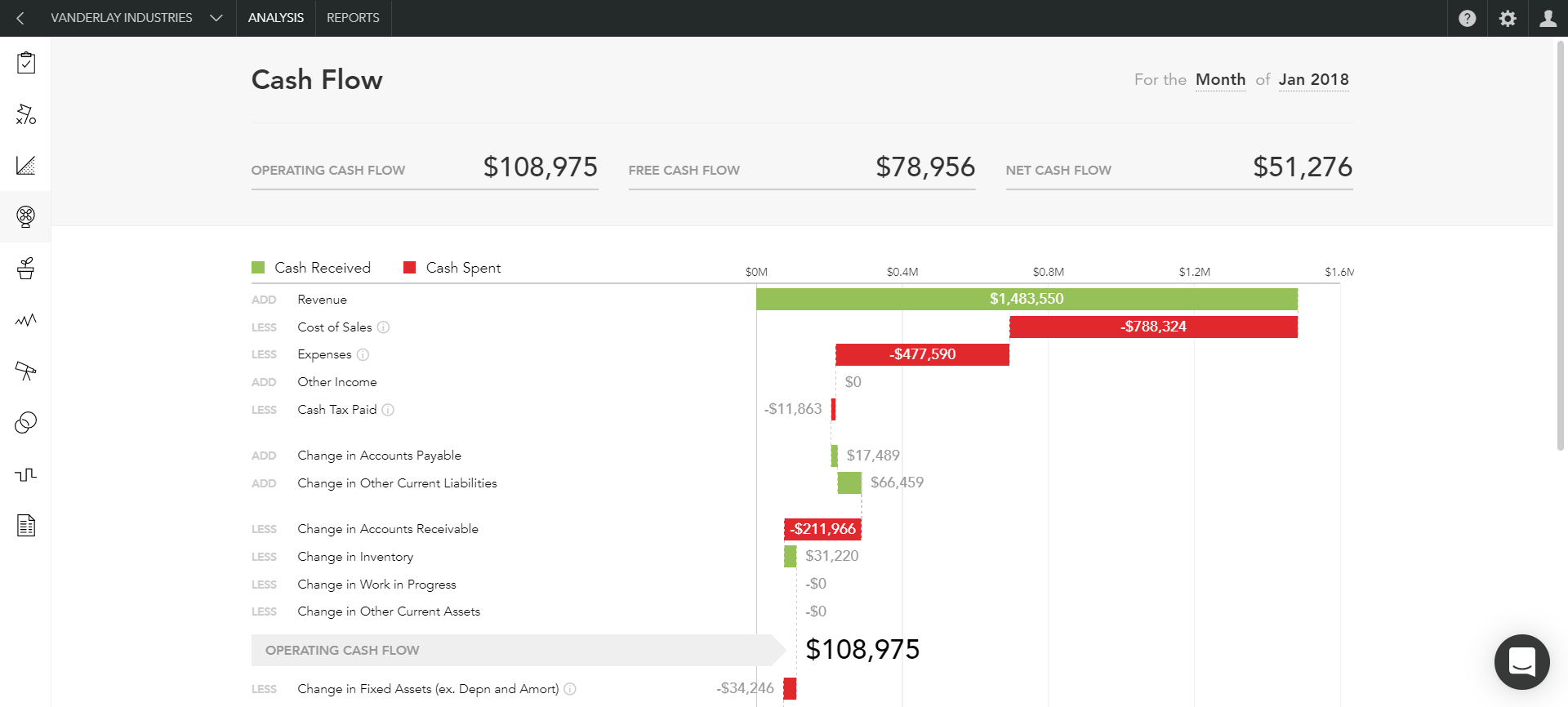
This shows money coming in and going out as if it is flowing down a waterfall, with money coming in colored in green and money going out colored in red.
All of our clients now understand their cash-flow, as it has come alive, visually.
Key Performance Indicators
Most businesses must track a few Key Performance Indicators, and again, showing in black and white can be quite bland, non-attention grabbing and not emphasizing critical decisions that need to be made by using “red” and “green” to highlight key numbers.
Let me show you an example of how presentation can drive you to know your business better, ask better questions, and then, as a result, make informed, trackable business decisions
Take a look at these two common reports – an Income Statement and a Balance Sheet:
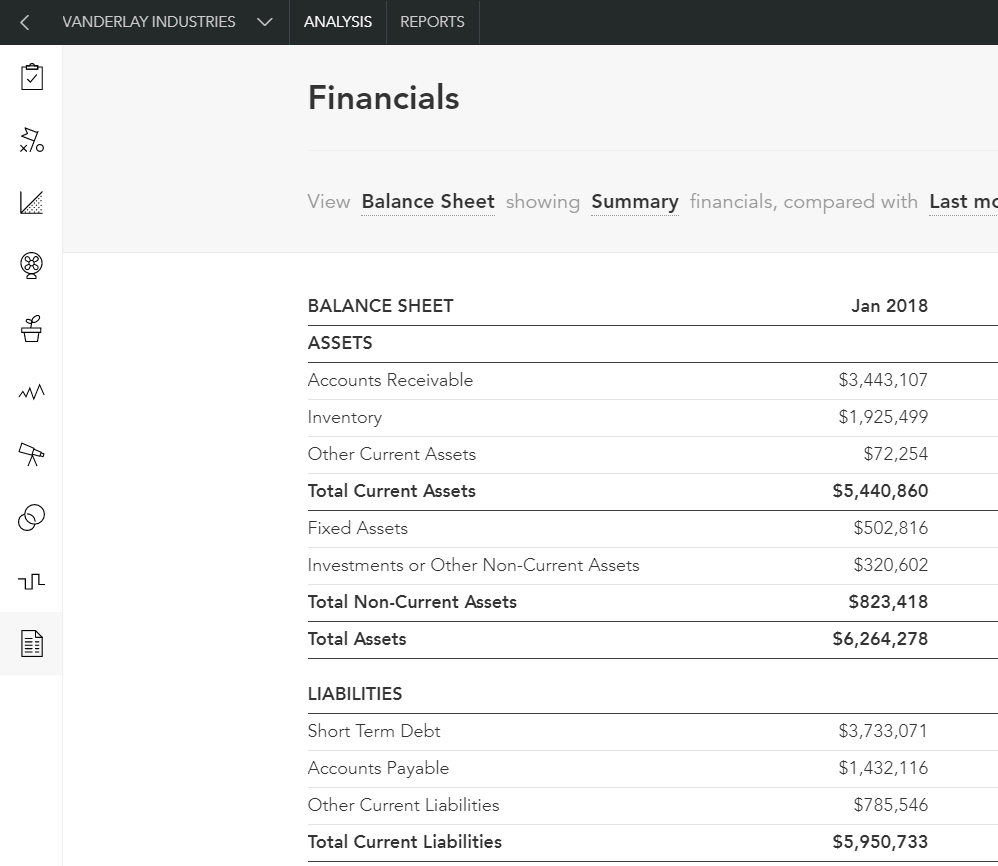
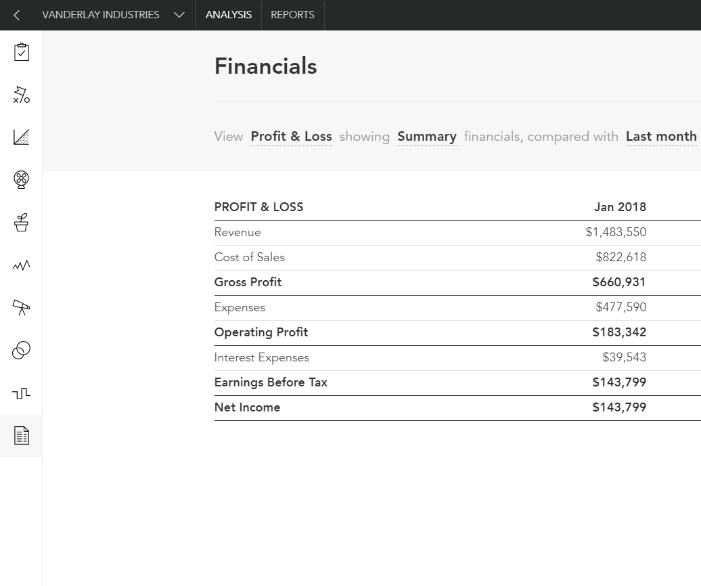
All of the information contained therein is rather meaningless without two things:
- Something to compare it to
- Ratios and indicators derived from the above numbers
Finally, by adding color, they sparkle and pop, coming alive!
First, let’s see the impact of adding comparative numbers to the two standard reports above:
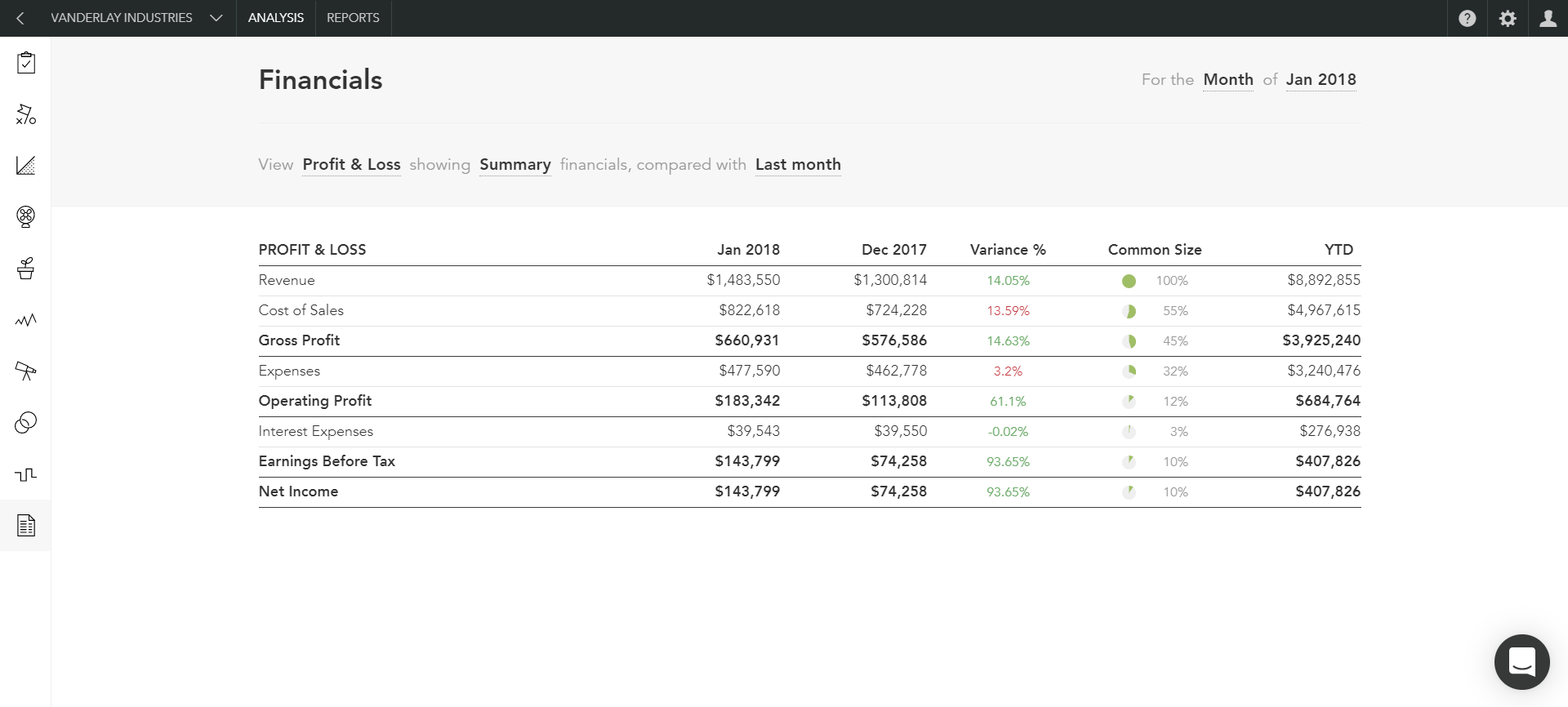
The above Income Statement now has a comparative column showing the month before and a variance column showing the changes. When it is a positive variance it is green, when negative, red. There is also a column showing the year-to-date figures.
We could compare the numbers to a Target or Budget.
You see, without a comparison, the first column has no meaning (or very limited meaning).
Now, take a look at this Chart:
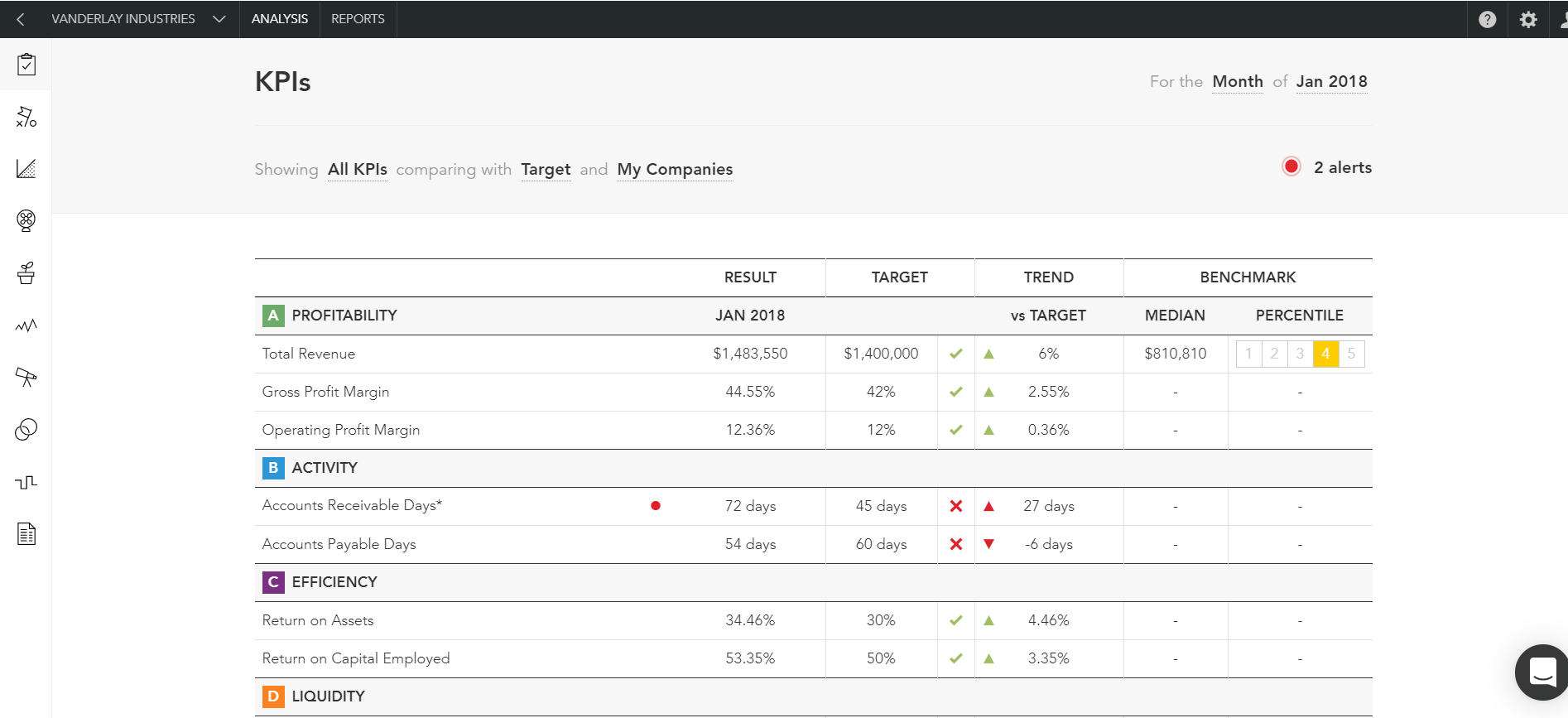
All of the numbers above are derived from the two reports above. However, what a simple dashboard like this gives you is the following:
- A goal to aim for – the Target and whether you hit it, or not
- When you hit it, you get a green checkmark
- When you don’t, you get a red cross
- These numbers can be compared to Benchmarks as well
This simple dashboard can give you, the business owner a condensed, summarized view of your business.
Here is an example of how that report can drive business decisions. Firstly, let’s look at the first red X – Accounts Receivable Days.
The target is 45 days. The actual is 72 days. What does this mean, you may ask? It means that on average it is taking you 72 days to collect your accounts receivable. This is a long time to wait to be paid, and it is definitely longer than your pre-set Target.
This observation can lead to more questions:
- Have we softened our credit terms, allowing people to take longer to pay us?
- Have we taken on poor paying customers, just to get a sale, and now they cannot pay us?
- Do we even have a credit policy, and should we change it?
Now, you can really dig in and get some answers which will lead you, as business owner, to take action in the critically important area of your business – cash-flow!
Trends
Looking at what is happening as a Trend, again in color, and in an attractive visual way can really help spot things you might not see looking a black and white row of numbers.
Option 1 is to present your numbers in a simple table, like this:
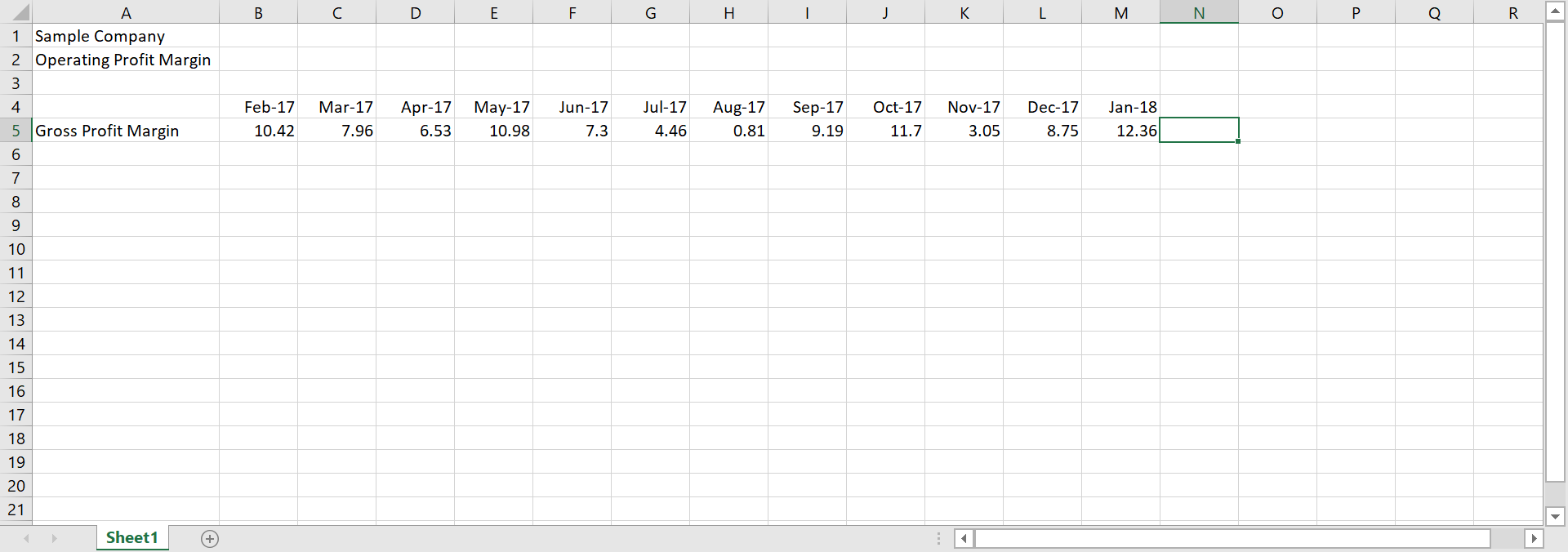
Although the image below is a bit smallish to scale for this Blog, look at the difference, with the exact same numbers as presented below.
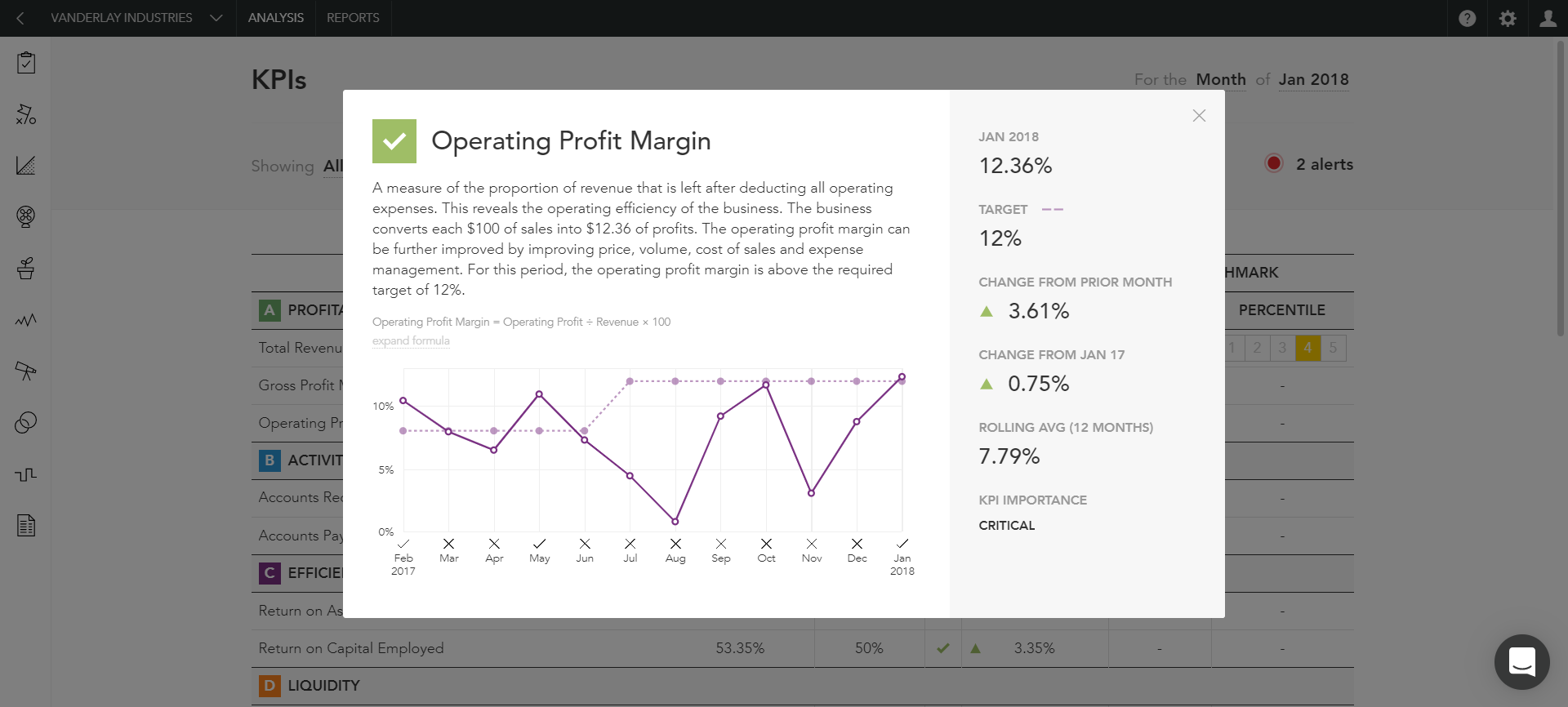
What pops out first is that big drop in August, which just doesn’t stand out in the first Chart above. This can lead to more questions and further investigation.
As you will note, on the side bar, in addition are included the operating margin for the current month, compared to the Target, the positive change from the month before, and from the same month in the prior year, and, finally, the rolling 12-month average.
Conclusion
How your numbers are presented to you has the following critically important benefits:
- Your understanding of your business deepens
- The numbers will often lead to asking better and more relevant questions
- The decisions you make will have more meaning when tracked by the numbers.
Here is an example. We recently implemented a powerful software that helps improve the speed of collections on our clients accounts receivable. Because we track Accounts Receivable Days for all our clients, we can spot numbers off-Target and provide solutions.
We could see quite quickly that this powerful software had an impact on the Accounts Receivable Days. It went down, which is favorable.
Finally, even more important than nice visuals are having reports that are impeccable, with reliable, solid numbers. That is what we provide, and without that, nothing else will work.
Thanks for reading…


 A Little Boy’s Toy
A Little Boy’s Toy





